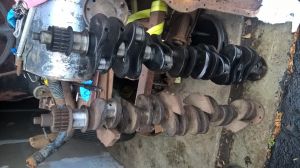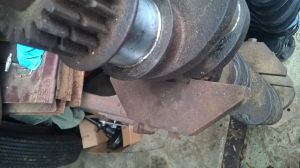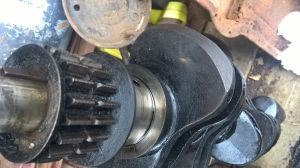- Home
- About Us
- Join/Renew
- Member Benefits
- Member Pages
- Log In
- Help
- Museum Store
Happy New Years everyone. In order to escape putting away Christmas decorations, I went over to my storage and picked up the ’35 crank I am going to send to the shop to clean, polish and check size.
Just for interest, I pulled out my ’33 crank that had already been turned down to .010″ under, years ago for a side to side comparison.
The black crank is the one out of the ’35 and the rusty looking one is the one that came with my 836.

One noticeable difference in the two cranks is the bolt on counterweights on the early engine.

Here is the newer one.

The later crank’s lobs were drilled for balance. Cost cutting, I guess
Bill,
Another difference I noticed seeing your cranks side by side: On my ’33, the threads engaging the nut to hold the vibration damper on, only engaged ⅝” of the 1″ thick nut, leaving a ⅜” “canyon”. I always wondered if somebody shortened my threads for some reason, and worried that the engagement was less than optimum. It now looks like it was a factory dimension, that although provided enough holding force, would be better if longer, and they realized that later. My ’34 is indeed about ¼” longer like your ’35 (and has integral counterweights).
Happy New Year!
Bob,
The non counter weight crank still has the flywheel bolts in it, so it looks a little longer, but the threaded part is longer I believe
The bolt-on counterweights were less than ideal because holding them on required drilling and threading the crank putting stress concentrations near the main bearing cheeks. It looks like they must be removed to grind the journals. Casting or forging the counterweights integral with the crank as one piece should be better structurally with less chance of fatigue failure.
The later integral counterweights are also symmetric around each con rod instead of just 4 large bolt-ons offset from the centers of mass of the rods and pistons. I think the later crank is a significant design improvement and likely was more expensive rather than less to balance each throw. It is also nice that the counterweights don’t have to be removed to grind the journals.
Do the first eights have counterweights at all? Theoretically an inline eight does not need counterweights to be in balance, the main purpose of the counterweights is to reduce the load on the main bearings from the piston and rod inertia at high RPM, so counterweights became more important as engine RPM’s were pushed higher.
Jim, my 1930 crank has no counterweights.
1929 has weights, 1930 does not, 1931 does, 1932 does not, 1933 has them. And you wonder why Pierce went out of business. Not all cranks interchange. Putting in a late model crank will take you from 366 to 385 CID.
